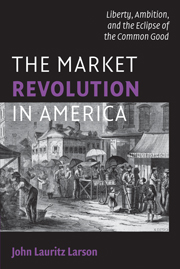Book contents
- Frontmatter
- Contents
- Acknowledgments
- Introduction: What Do We Mean by a Market Revolution in America?
- 1 First Fruits of Independence
- Interlude: Panic! 1819
- 2 Marvelous Improvements Everywhere
- Interlude: Panic! 1837
- 3 Heartless Markets, Heartless Men
- 4 How Can We Explain It?
- Epilogue: Panic! 2008, Déjà vu All over Again
- An Essay on the Sources
- Index
Epilogue: Panic! 2008, Déjà vu All over Again
Published online by Cambridge University Press: 05 June 2012
- Frontmatter
- Contents
- Acknowledgments
- Introduction: What Do We Mean by a Market Revolution in America?
- 1 First Fruits of Independence
- Interlude: Panic! 1819
- 2 Marvelous Improvements Everywhere
- Interlude: Panic! 1837
- 3 Heartless Markets, Heartless Men
- 4 How Can We Explain It?
- Epilogue: Panic! 2008, Déjà vu All over Again
- An Essay on the Sources
- Index
Summary
The Panic of 2008 struck while I was finishing this book. During the third week of September, networks of short-term credit that fed the cash needs of banks, brokerages, and large corporations started to freeze up. Declining value of capital assets was forcing lending institutions to call in loans and reduce their exposure, setting off the familiar downward spiral that makes investors panic. Markets recoiled in surprise, and confidence – that mysterious, invisible energy that keeps all financial bodies snug in their proper orbits – began to evaporate.
In the late twentieth century, capitalists worldwide had come to believe that institutional firewalls, sophisticated central banks, and modern regulatory regimes had consigned this nightmare scenario to the dustbin of historical fantasies – but here it was in the autumn of 2008 spinning madly out of control. Giant banks defaulted, stock markets shuddered, and financial institutions refused to lend to each other for fear that the morning news would report further bankruptcies. Thriving industries found it impossible to sell the commercial paper (very short-term loans) that allowed them to pay for materials and parts or meet their weekly payrolls. Money markets seized up. The interest rate on United States Treasury Bills, thought to be the last safe haven for cash, fell to zero. (In effect, investors were paying the treasury to keep their money.) By late September, had there still been windows that opened onto Wall Street, rich, young MBAs might have been falling like rain.
- Type
- Chapter
- Information
- The Market Revolution in AmericaLiberty, Ambition, and the Eclipse of the Common Good, pp. 169 - 185Publisher: Cambridge University PressPrint publication year: 2009



